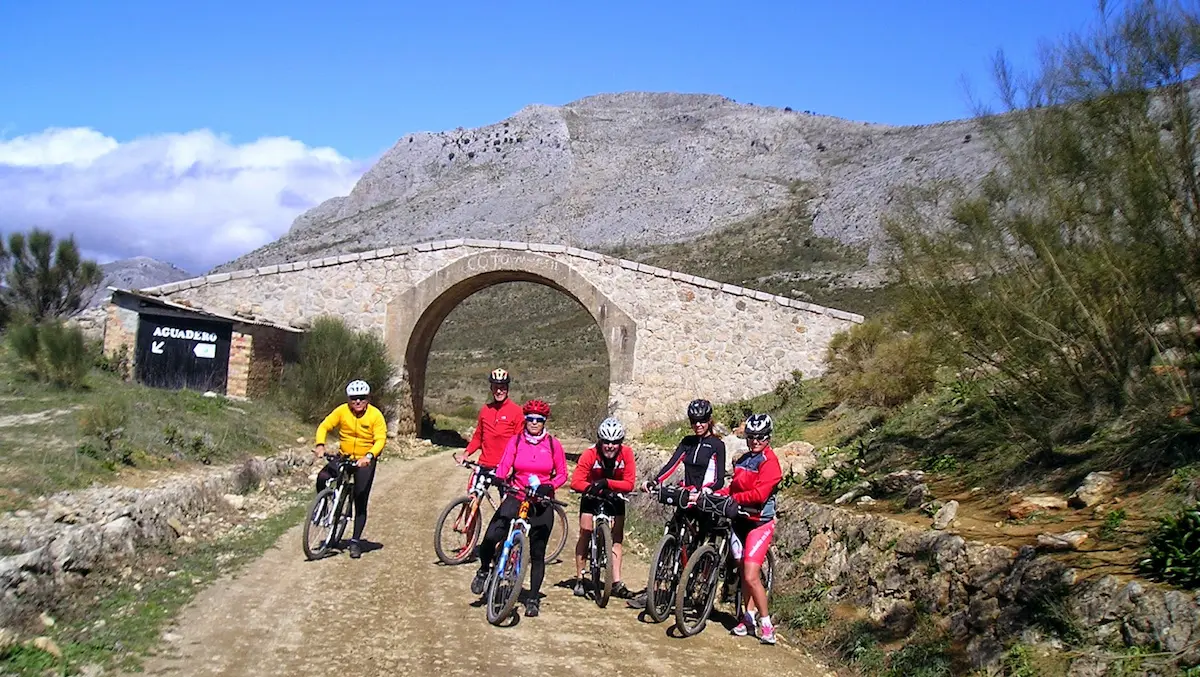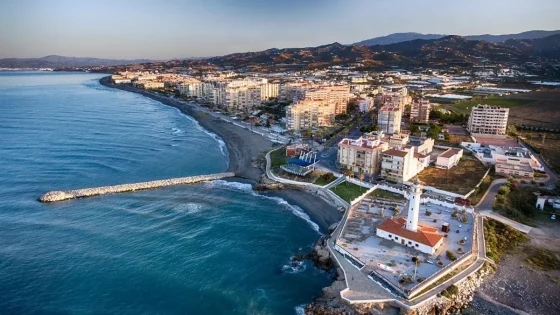
Located in the highlands of Axarquía, Periana is one of the most beautiful white towns in inland Málaga, known as the natural amphitheater of Europe, thanks to its privileged location on the slopes of the Sierra de Alhama.
Its unique architecture and panoramic views of a unique natural environment make this town a place of great tourist interest for visitors. Here, you can enjoy a disconnecting experience with the finest gastronomy and various hiking routes in the midst of nature.
To visit Periana, the best option is to hire an automatic car at Malaga Airport since this town in the Axarquía region is located in the middle of the mountains and therefore does not have many public transport connections.
Table of Contents
History of Periana
The history of Periana has its earliest traces in Prehistory, with evidence of human settlements. With the arrival of the Arab civilization, Periana was established as a passage for Christian troops, and it wasn’t until the 18th century that it was established as a town, converting its hermitage into a church.
A century later, in 1884, a major earthquake destroyed much of the city and killed many of its inhabitants. Thanks to the funds offered by Alfonso XII, the town was rebuilt, becoming what it is today.

Today, its people have focused their work on agriculture, with a focus on peach and olive oil production, earning it a place on the Olive Oil and Montes de Málaga Route, along with other towns like Colmenar and Riogordo.
What to See and Do in Periana
Although not a large town, Periana is one of the destinations worth visiting, both for its unique architecture, nature, traditions, and gastronomy.
What to See in Periana
In the route through the towns of Axarquía in Malaga, Periana is one of the simplest but with a lot to offer to visitors. Walking through its streets is like traveling back in time, with traditional buildings and white streets that transmit peace to visitors.
Church of San Isidro Labrador
The Church of San Isidro Labrador is the most prominent monument in Periana. Built in neo-Mudejar style after the earthquake of 1884, it features an impressive structure with three naves separated by pointed arches.

Its exterior highlights the exposed brick facade, while inside, the polychrome terrazzo flooring is a surprising feature. Undoubtedly, this is the most highly regarded monument by the people of Periana due to its historical significance.
18th-Century Manor Houses, Municipal Washhouse, and Periana Fountain
During your visit to Periana, you will discover the charming 18th-century manor houses that adorn the streets. Additionally, you can appreciate the old municipal washhouse, a witness to the town’s traditions.
Another point of interest is the Periana Fountain, which has been the center of social life and a meeting place for the townspeople for decades. It has undergone renovations due to the effects of the earthquake.
Periana celebrates various festivals and events throughout the year, where visitors can experience authentic Andalusian culture. The main festivities take place from the beginning of spring through the summer, coinciding with the best weather in the area.
Vilo Baths
Just two and a half kilometers from the town, in the hamlet of the same name, you will find the Vilo Baths. This natural bath, located over 600 meters above sea level, houses a well-carved pool that is over a thousand years old.

The beauty of the surrounding landscape and the therapeutic properties of its calcium and nitrogen-rich waters, discovered and exploited by the Arabs, make it an essential place to visit and relax.
Mondrón Olive Oil Museum
The Mondrón Olive Oil Museum deserves special mention even though it is not located within the town itself since it represents the agricultural tradition of Periana. In its facilities, you can immerse yourself in the culture of olive oil, discovering the ancient tools and grinding stones used in its production.

This museum is located in the olive-growing village of Mondrón, 6 km from Periana. Here, you can get up close to the processes that have brought fame to this area and enjoy an enriching experience. Additionally, you can purchase products at its store.
Nature and Hiking
Periana boasts a rich natural environment, with stunning mountain landscapes and olive and crop fields. In its surroundings, you can find ideal routes for hiking, cycling, or bird watching, ranging from easy to physically challenging ones that connect some of the localities in the area.
Tajo Route
This circular route starts in Periana and goes to the town of Vilo, where you can visit its famous baths. Along the way, you will pass through the towns of Moya and Vilo, traveling on paved or dirt roads.
Starting at the town hall square, head towards the cemetery, taking the turn towards Moya, a village located on a surprising cliff in the mountains. Then, continue crossing the Guaro River, walking to Vilo.
During the journey, you can enjoy a natural environment dominated by olive, peach, and quince orchards, and you will find stunning views at Tajo de Moya. Take a break in Vilo before retracing your steps back to Periana.
Key Information
- Estimated Time: 2 hours
- Distance: 8 km
- Elevation Gain: 182 m
- Approximate Location: Sierra de Alhama and Sierra de Enmedio
- Difficulty: Easy
Train Route
The route begins at the roundabout at the entrance to Periana, ascending along the path to the right. After 700 meters, at the intersection, turn towards El Cantueso on a dirt road, enjoying a breathtaking panoramic view of the area.

Continuing along the trail, you will cross the regional road with caution and follow the dirt road, where you can find remnants of the old train tracks.
Then, upon reaching Cortijo Cañizares, continue along the dirt road to the Old Matanza Station. After exploring the station, the return journey begins on the A-7204 road back to Periana.
On the way, you will pass by interesting places like the Aldea de Pollo Pelao and the Curva de Caga Oro. Finally, at the entrance to Periana, you will find the Mirador de la Peña, marking the final stretch of the route.
Key Information
- Estimated Time: 2 hours and 37 minutes
- Distance: 9.97 km
- Elevation Gain: 329 m
- Approximate Location: El Cantueso Area
- Difficulty: Moderate
Archaeological Route
The route begins at the Town Hall, descending along Bellavista Promenade to the Pine Park and the Church of San Isidro Labrador. Continue along Carrascal Street, passing by the Periana Olive Cooperative and reaching Peñas-Pardas.
There, you should take the Algarrobal Path, a steep asphalt lane surrounded by vegetation. Later, you’ll find a left turn onto a dirt lane leading to Las Mayoralas, where you can rest and enjoy views of the Viñuela Reservoir.

Following the path, you’ll cross the Guaro River, skirt the reservoir, and reach the Cerro de la Capellanía, with Roman ruins and panoramic views. Finally, you’ll return along the same path to Periana.
Key Information
- Estimated Time: 3 hours and 53 minutes
- Distance: 14.79 km
- Elevation Gain: 552 m
- Approximate Location: Las Mayoralas and Viñuela Reservoir
- Difficulty: Moderate to High
Popular Festivals and Cuisine
If anything defines a town, it’s its customs and its most typical dishes, which bear witness to its history and the passage of time among its people. Here are some of the most relevant ones.
Popular Festivals of Periana
Periana is famous for its numerous popular festivals held throughout the year. In May, the town pays tribute to San Isidro Labrador with festivals, concerts, and the emotional procession of the saint through the streets of the town.

During the summer, Periana celebrates the main festival during the August Fair and the Peach Day, which praises one of the most emblematic products of the region. There is a gastronomic competition where participants create dishes based on this delicious fruit typical of the area.
Another day of celebration centered around its typical products is Olive Verdial Day, a celebration declared of Provincial Tourist Interest. During this event, you can enjoy an authentic ‘miller’s breakfast,’ taste local products, and participate in olive oil tastings. All of this is accompanied by the joyful music of the verdiales.
Periana’s cuisine stands out for its traditional dishes made with local products, with olive oil and peaches being among the main highlights.
Notable dishes include cachorreñas soups, migas, and ajoblanco. There are also parpuchas, cod fritters served with honey, and morretes with almond sauce, an exquisite combination of asparagus, mushrooms, potatoes, and a delicious sauce.

Desserts include the famous peaches of Periana, Roman and olive oil cakes, and wine roscos. Undoubtedly, Periana’s cuisine offers a variety of tasty dishes to please every palate.
How to Get to Periana
Periana is located in the interior of the province, about an hour’s drive from the capital. However, there are also other options for those who do not have a car, although the connections are limited.
How to Get There by Public Transport
If you want to get to Periana from Malaga using public transport, you can take a bus from the Malaga Bus Station. There are regular services connecting both towns, with an estimated travel time of around one and a half hours, at an average cost of 5 euros, with four connections per day.
How to Get There by Car
If you choose to drive to Periana from Malaga, the journey is quite straightforward:
- From the center of Malaga, take the A-45 motorway towards Antequera/Granada.
- Continue on this road until you reach exit 138 towards Vélez-Málaga.
- Take the A-356 road towards Viñuela/Alhama de Granada. Continue on this road until you reach Periana.
The estimated travel time between the capital and this town is approximately 50 minutes, depending on traffic.
Map of Periana
Periana is a perfect getaway for a weekend visiting the inland villages of the Costa del Sol. In the following map, you can locate the main points of interest so you don’t miss anything during your trip.



